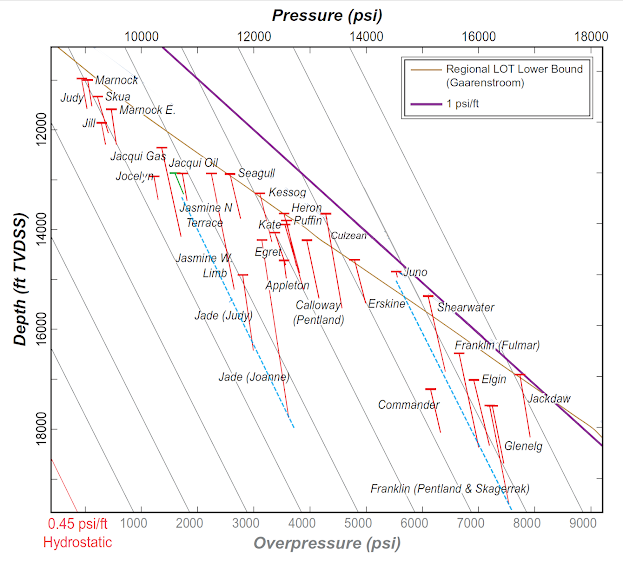First let’s estimate the maximum rate of oil generation
in a geological setting. Lets take a very good source rock, with an S2 yield of
30 mg/gRock (5% TOC and 600 mg/g HI). That is 3% in weight of HC generation
potential. Converting to volume, it becomes 6 to 10% of the rock volume,
depending on HC density (eg. 0.06 to 0.1 m3 per cubic meter of
rock). Lets take the high end, and assume a short oil window of 10 million
years (most oil windows are longer), the rate of generation is 0.1m3 /10,000,000year,
or 10-8 m3/ year, or 0.01 cc per year. Since a typical
liquid drop contains 0.05 cc, this means in one cubic meter of rock, the source
rock generates one drop of oil every 5 years!
Now go on and think about how much pressure that generates,
and whether this has any chance of making fractures in the source rock. Compare
that one drop every 5 years rate with the 60 barrels per minute fluid injection
rate we use to hydraulically frack the same rock.
Source rocks are quite "permeable" given geological time is 7 more more orders of magnitude longer than production time. Migration really does not require micro fractures. We have 10s of million years of time and a migration rate of only 0.0005 m/year is required to allow for the volume generated, creeping one pore space over a few years - at which rate, according to capillary number theory, it becomes a capillary dominated system, and viscosity (therefore permeability) does not even play a role.
Even during gas generation, the volume increase is still minimal. Typical good marine source rocks generate only 10 to 20% of its potential as gas, and less than 30% including cracking of oil retained in the source rock. In situ gas density is lower, and volume may be 3 to 5 times of that for oil. So we are still in the same rate range of less than 0.1 cc/year volume generated in 1 cubit meter of rock maximum.
I do not believe these rates can cause micro fracturing, and do not believe micro-fractures are necessary for primary migration. As HC generation happens almost uniformly everywhere in a mature source rock, fractures should be everywhere and in every mature source rock if they are required for expulsion/primary migration. We just don't see that, far from that.
We do see micro-fractures in some source rocks, sometimes, most noticeable are those calcite filled "beef" like fractures are probably not caused by HC generation - but more likely formed during diagenesis before generation occurred. Micro-fractures are not present, or not pervasive in most mature source rocks, especially clay rich lacustrine and marine source rocks. Occasionally we observe a few bitumen filled fractures but they tend to be a just a few, localized, not everywhere you would expect due to HC generation. Bitumen filled fractures are also not proof HC generation was the cause of the fractures. An simpler explanation of these is simply tectonic (especially shear) stress. Some "fractures" in lab pyrolysis experiments are typically along bedding and probably caused by the thermal expansion of the rock during the experiments - even if we ignore the 13 orders of magnitude in heating (generation) rate. Even at such high generation rate in the lab, Grohmann et al. (2021) shows that even 1 bar of vertical stress inhibits fracturing, as compared to the 100s of bars in geological conditions.
References:
R. Lenormand, E. Touboul and C. Zarcone, 1988, Numerical models and experiments on immiscible displacements in porous media, Journal of Fluid Mechanics 189(-1):165 - 187
S. Grohmann et al. Hyrous Pyrolysis of Source Rock Plugs: Geochemical and Visual Investigations and Implications for Primary Migration, 2021, IMOG conference paper.


